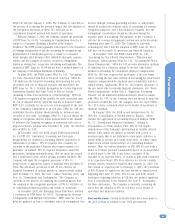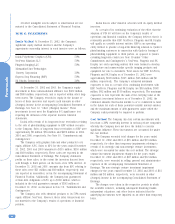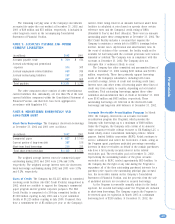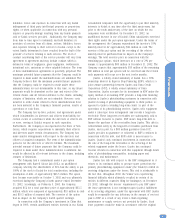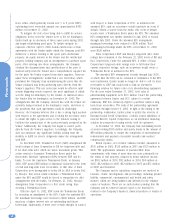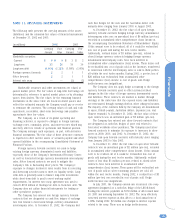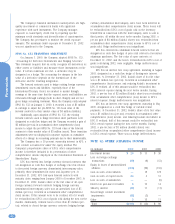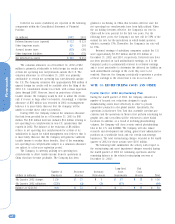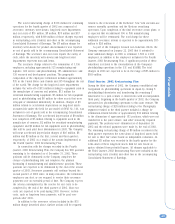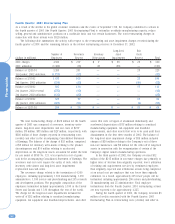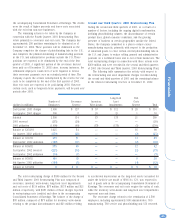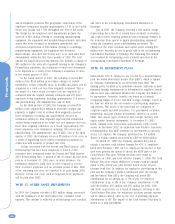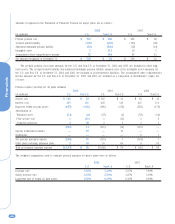Kodak 2002 Annual Report Download - page 58
Download and view the complete annual report
Please find page 58 of the 2002 Kodak annual report below. You can navigate through the pages in the report by either clicking on the pages listed below, or by using the keyword search tool below to find specific information within the annual report.
Financials
58
lease terms, which generally extend over 5 to 7 years. ESF’s
outstanding lease receivable amount was approximately $473
million at December 31, 2002.
To mitigate the risk of not being able to fulfill its service
obligations in the event the Vendor were to file for bankruptcy,
Qualex built up its inventory of these spare parts during 2002
and began refurbishing used parts. To further mitigate its
exposure, effective April 3, 2002, Kodak entered into certain
agreements with the Vendor under which the Company paid $19
million for a license relating to the spare parts intellectual
property, an equity interest in the Vendor and the intellectual
property holding company and an arrangement to purchase spare
parts. After entering into these arrangements, the Company
obtained the documentation and specifications of the parts it
sourced solely from the Vendor and a comprehensive supplier list
for the parts the Vendor sourced from other suppliers. However,
under these arrangements, Kodak had a use restriction, which
precluded the Company from manufacturing the parts that the
Vendor produced and from purchacing parts directly from the
Vendor’s suppliers. This use restriction would be effective until
certain triggering events occurred, the most significant of which
was the filing for bankruptcy by the Vendor. As indicated above,
the Vendor filed for bankruptcy on December 24, 2002. The
arrangements that the Company entered into with the Vendor are
currently being reviewed in the bankruptcy courts, and there is
the possibility that such agreements could be challenged.
However, the Company believes that it has a strong legal position
with respect to the agreements and is taking the necessary steps
to obtain the rights to gain access to the Vendor’s tooling to
facilitate the manufacture of the parts previously produced by the
Vendor. Additionally, the Company has begun to source parts
directly from the Vendor’s suppliers. Accordingly, the Company
does not anticipate any significant liability arising from the
inability to fulfill its service obligations under the arrangement
with ESF.
In December 2001, Standard & Poor’s (S&P) downgraded the
credit ratings of Dana Corporation to BB for long-term debt and
B for short-term debt, which are below investment grade. This
action created a Guarantor Termination Event under the
Receivables Purchase Agreement (RPA) between ESF and its
banks. To cure the Guarantor Termination Event, in January
2002, ESF posted $60 million of additional collateral in the form
of cash and long-term lease receivables. At that time, if Dana
Corporation were downgraded to below BB by S&P or below Ba2
by Moody’s, that action would constitute a Termination Event
under the RPA and ESF would be forced to renegotiate its debt
arrangements with the banks. On February 22, 2002, Moody’s
downgraded Dana Corporation to a Ba3 credit rating, thus
creating a Termination Event.
Effective April 15, 2002, ESF cured the Termination Event
by executing an amendment to the RPA. Under the amended RPA,
the maximum borrowings were lowered to $400 million, and ESF
must pay a higher interest rate on outstanding and future
borrowings. Additionally, if there were certain changes in control
with respect to Dana Corporation or DCC, as defined in the
amended RPA, such an occurrence would constitute an event of
default. Absent a waiver from the banks, this event of default
would create a Termination Event under the RPA. The amended
RPA arrangement was further amended in July 2002 to extend
through July 2003. Under the amended RPA arrangement,
maximum borrowings were reduced to $370 million. Total
outstanding borrowings under the RPA at December 31, 2002
were $320 million.
Dana Corporation’s S&P and Moody’s long-term debt credit
ratings have remained at the February 22, 2002 levels of BB and
Ba3, respectively. Under the amended RPA, if either of Dana
Corporation’s long-term debt ratings were to fall below their
current respective ratings, such an occurrence would create a
Termination Event as defined in the RPA.
The amended RPA arrangement extends through July 2003,
at which time the RPA can be extended or terminated. If the RPA
were terminated, Qualex would no longer be able to sell its lease
receivables to ESF and would need to find an alternative
financing solution for future sales of its photofinishing equipment.
For the year ended December 31, 2002, total sales of
photofinishing equipment were $3.5 million. Under the partnership
agreement between Qualex and DCC, subject to certain
conditions, ESF has exclusivity rights to purchase Qualex’s long-
term lease receivables. The term of the partnership agreement
continues through October 6, 2003. In light of the timing of the
partnership termination, Qualex plans to utilize the services of
Eastman Kodak Credit Corporation, a wholly owned subsidiary of
General Electric Capital Corporation, as an alternative financing
solution for prospective leasing activity with its customers.
At December 31, 2002, the Company had outstanding letters
of credit totaling $105 million and surety bonds in the amount of
$79 million primarily to ensure the completion of environmental
remediations and payment of possible casualty and workers’
compensation claims.
Rental expense, net of minor sublease income, amounted to
$158 million in 2002, $126 million in 2001 and $155 million in
2000. The approximate amounts of noncancelable lease
commitments with terms of more than one year, principally for
the rental of real property, reduced by minor sublease income,
are $102 million in 2003, $72 million in 2004, $56 million in
2005, $42 million in 2006, $32 million in 2007 and $51 million
in 2008 and thereafter.
The Company and its subsidiary companies are involved in
lawsuits, claims, investigations and proceedings, including product
liability, commercial, environmental, and health and safety
matters, which are being handled and defended in the ordinary
course of business. There are no such matters pending that the
Company and its General Counsel expect to be material in
relation to the Company’s business, financial position or results of
operations.



